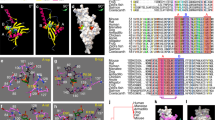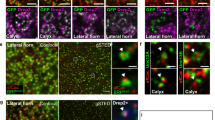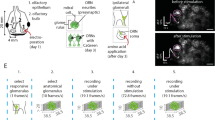Abstract
In olfactory sensory neurons (OSNs), cytosolic Ca2+ controls the gain and sensitivity of olfactory signaling. Important components of the molecular machinery that orchestrates OSN Ca2+ dynamics have been described, but key details are still missing. Here, we demonstrate a critical physiological role of mitochondrial Ca2+ mobilization in mouse OSNs. Combining a new mitochondrial Ca2+ imaging approach with patch-clamp recordings, organelle mobility assays and ultrastructural analyses, our study identifies mitochondria as key determinants of olfactory signaling. We show that mitochondrial Ca2+ mobilization during sensory stimulation shapes the cytosolic Ca2+ response profile in OSNs, ensures a broad dynamic response range and maintains sensitivity of the spike generation machinery. When mitochondrial function is impaired, olfactory neurons function as simple stimulus detectors rather than as intensity encoders. Moreover, we describe activity-dependent recruitment of mitochondria to olfactory knobs, a mechanism that provides a context-dependent tool for OSNs to maintain cellular homeostasis and signaling integrity.
This is a preview of subscription content, access via your institution
Access options
Subscribe to this journal
Receive 12 print issues and online access
$209.00 per year
only $17.42 per issue
Buy this article
- Purchase on Springer Link
- Instant access to full article PDF
Prices may be subject to local taxes which are calculated during checkout








Similar content being viewed by others
References
Firestein, S. How the olfactory system makes sense of scents. Nature 413, 211–218 (2001).
Spehr, M. & Munger, S.D. Olfactory receptors: G protein-coupled receptors and beyond. J. Neurochem. 109, 1570–1583 (2009).
Buck, L. & Axel, R. A novel multigene family may encode odorant receptors: a molecular basis for odor recognition. Cell 65, 175–187 (1991).
Bakalyar, H.A. & Reed, R.R. Identification of a specialized adenylyl cyclase that may mediate odorant detection. Science 250, 1403–1406 (1990).
Nakamura, T. & Gold, G.H. A cyclic nucleotide-gated conductance in olfactory receptor cilia. Nature 325, 442–444 (1987).
Dhallan, R.S., Yau, K.W., Schrader, K.A. & Reed, R.R. Primary structure and functional expression of a cyclic nucleotide-activated channel from olfactory neurons. Nature 347, 184–187 (1990).
Kleene, S.J. & Gesteland, R.C. Calcium-activated chloride conductance in frog olfactory cilia. J. Neurosci. 11, 3624–3629 (1991).
Stephan, A.B. et al. ANO2 is the cilial calcium-activated chloride channel that may mediate olfactory amplification. Proc. Natl. Acad. Sci. USA 106, 11776–11781 (2009).
Billig, G.M., Pal, B., Fidzinski, P. & Jentsch, T.J. Ca2+-activated Cl− currents are dispensable for olfaction. Nat. Neurosci. 14, 763–769 (2011).
Cygnar, K.D. & Zhao, H. Phosphodiesterase 1C is dispensable for rapid response termination of olfactory sensory neurons. Nat. Neurosci. 12, 454–462 (2009).
Boccaccio, A., Lagostena, L., Hagen, V. & Menini, A. Fast adaptation in mouse olfactory sensory neurons does not require the activity of phosphodiesterase. J. Gen. Physiol. 128, 171–184 (2006).
Matthews, H.R. & Reisert, J. Calcium, the two-faced messenger of olfactory transduction and adaptation. Curr. Opin. Neurobiol. 13, 469–475 (2003).
Reisert, J. & Matthews, H.R. Adaptation of the odour-induced response in frog olfactory receptor cells. J. Physiol. (Lond.) 519, 801–813 (1999).
Kurahashi, T. & Menini, A. Mechanism of odorant adaptation in the olfactory receptor cell. Nature 385, 725–729 (1997).
Bradley, J., Bonigk, W., Yau, K.W. & Frings, S. Calmodulin permanently associates with rat olfactory CNG channels under native conditions. Nat. Neurosci. 7, 705–710 (2004).
Chen, T.Y. & Yau, K.W. Direct modulation by Ca2+-calmodulin of cyclic nucleotide-activated channel of rat olfactory receptor neurons. Nature 368, 545–548 (1994).
Munger, S.D. et al. Central role of the CNGA4 channel subunit in Ca2+-calmodulin-dependent odor adaptation. Science 294, 2172–2175 (2001).
Bradley, J., Reisert, J. & Frings, S. Regulation of cyclic nucleotide-gated channels. Curr. Opin. Neurobiol. 15, 343–349 (2005).
Kleene, S.J. The electrochemical basis of odor transduction in vertebrate olfactory cilia. Chem. Senses 33, 839–859 (2008).
Leinders-Zufall, T., Greer, C.A., Shepherd, G.M. & Zufall, F. Imaging odor-induced calcium transients in single olfactory cilia: specificity of activation and role in transduction. J. Neurosci. 18, 5630–5639 (1998).
Noé, J., Tareilus, E., Boekhoff, I. & Breer, H. Sodium/calcium exchanger in rat olfactory neurons. Neurochem. Int. 30, 523–531 (1997).
Reisert, J. & Matthews, H.R. Response properties of isolated mouse olfactory receptor cells. J. Physiol. (Lond.) 530, 113–122 (2001).
Stephan, A.B. et al. The Na+/Ca2+ exchanger NCKX4 governs termination and adaptation of the mammalian olfactory response. Nat. Neurosci. 15, 131–137 (2011).
Antolin, S., Reisert, J. & Matthews, H.R. Olfactory response termination involves Ca2+-ATPase in vertebrate olfactory receptor neuron cilia. J. Gen. Physiol. 135, 367–378 (2010).
Weeraratne, S.D., Valentine, M., Cusick, M., Delay, R. & Van Houten, J.L. Plasma membrane calcium pumps in mouse olfactory sensory neurons. Chem. Senses 31, 725–730 (2006).
Berridge, M.J., Bootman, M.D. & Roderick, H.L. Calcium signalling: dynamics, homeostasis and remodelling. Nat. Rev. Mol. Cell Biol. 4, 517–529 (2003).
Zufall, F., Leinders-Zufall, T. & Greer, C.A. Amplification of odor-induced Ca2+ transients by store-operated Ca2+ release and its role in olfactory signal transduction. J. Neurophysiol. 83, 501–512 (2000).
Rizzuto, R. & Pozzan, T. Microdomains of intracellular Ca2+: molecular determinants and functional consequences. Physiol. Rev. 86, 369–408 (2006).
Kirichok, Y., Krapivinsky, G. & Clapham, D.E. The mitochondrial calcium uniporter is a highly selective ion channel. Nature 427, 360–364 (2004).
Baughman, J.M. et al. Integrative genomics identifies MCU as an essential component of the mitochondrial calcium uniporter. Nature 476, 341–345 (2011).
De Stefani, D., Raffaello, A., Teardo, E., Szabo, I. & Rizzuto, R. A forty-kilodalton protein of the inner membrane is the mitochondrial calcium uniporter. Nature 476, 336–340 (2011).
Palty, R. et al. NCLX is an essential component of mitochondrial Na+/Ca2+ exchange. Proc. Natl. Acad. Sci. USA 107, 436–441 (2010).
MacAskill, A.F. & Kittler, J.T. Control of mitochondrial transport and localization in neurons. Trends Cell Biol. 20, 102–112 (2010).
Chang, D.T. & Reynolds, I.J. Mitochondrial trafficking and morphology in healthy and injured neurons. Prog. Neurobiol. 80, 241–268 (2006).
Li, Z., Okamoto, K., Hayashi, Y. & Sheng, M. The importance of dendritic mitochondria in the morphogenesis and plasticity of spines and synapses. Cell 119, 873–887 (2004).
Cainarca, S. et al. A photoprotein in mouse embryonic stem cells measures Ca2+ mobilization in cells and in animals. PLoS ONE 5, e8882 (2010).
Veitinger, S. et al. Purinergic signalling mobilizes mitochondrial Ca2+ in mouse Sertoli cells. J. Physiol. (Lond.) 589, 5033–5055 (2011).
Spehr, M., Wetzel, C.H., Hatt, H. & Ache, B.W. 3-Phosphoinositides modulate cyclic nucleotide signaling in olfactory receptor neurons. Neuron 33, 731–739 (2002).
Oka, Y. et al. Odorant receptor map in the mouse olfactory bulb: in vivo sensitivity and specificity of receptor-defined glomeruli. Neuron 52, 857–869 (2006).
Rizzuto, R., Simpson, A.W., Brini, M. & Pozzan, T. Rapid changes of mitochondrial Ca2+ revealed by specifically targeted recombinant aequorin. Nature 358, 325–327 (1992).
Herrington, J., Park, Y.B., Babcock, D.F. & Hille, B. Dominant role of mitochondria in clearance of large Ca2+ loads from rat adrenal chromaffin cells. Neuron 16, 219–228 (1996).
Grosmaitre, X., Vassalli, A., Mombaerts, P., Shepherd, G.M. & Ma, M. Odorant responses of olfactory sensory neurons expressing the odorant receptor MOR23: a patch clamp analysis in gene-targeted mice. Proc. Natl. Acad. Sci. USA 103, 1970–1975 (2006).
Ben-Chaim, Y., Cheng, M.M. & Yau, K.W. Unitary response of mouse olfactory receptor neurons. Proc. Natl. Acad. Sci. USA 108, 822–827 (2011).
Song, Y. et al. Olfactory CNG channel desensitization by Ca2+/CaM via the B1b subunit affects response termination but not sensitivity to recurring stimulation. Neuron 58, 374–386 (2008).
Potter, S.M. et al. Structure and emergence of specific olfactory glomeruli in the mouse. J. Neurosci. 21, 9713–9723 (2001).
Fedrizzi, L. & Brini, M. Bioluminescent Ca2+ indicators. in Calcium Measurement Methods (eds. Verkhratsky, A. & Petersen, O.H.) 81–100 (Humana Press, 2010).
Detmer, S.A. & Chan, D.C. Functions and dysfunctions of mitochondrial dynamics. Nat. Rev. Mol. Cell Biol. 8, 870–879 (2007).
Reisert, J., Bauer, P.J., Yau, K.W. & Frings, S. The Ca-activated Cl channel and its control in rat olfactory receptor neurons. J. Gen. Physiol. 122, 349–363 (2003).
Restrepo, D., Okada, Y. & Teeter, J.H. Odorant-regulated Ca2+ gradients in rat olfactory neurons. J. Gen. Physiol. 102, 907–924 (1993).
Maue, R.A. & Dionne, V.E. Patch-clamp studies of isolated mouse olfactory receptor neurons. J. Gen. Physiol. 90, 95–125 (1987).
Mashukova, A., Spehr, M., Hatt, H. & Neuhaus, E.M. Beta-arrestin2-mediated internalization of mammalian odorant receptors. J. Neurosci. 26, 9902–9912 (2006).
Michalakis, S. et al. Loss of CNGB1 protein leads to olfactory dysfunction and subciliary cyclic nucleotide-gated channel trapping. J. Biol. Chem. 281, 35156–35166 (2006).
Hagendorf, S., Fluegge, D., Engelhardt, C. & Spehr, M. Homeostatic control of sensory output in basal vomeronasal neurons: activity-dependent expression of ether-a-go-go-related gene potassium channels. J. Neurosci. 29, 206–221 (2009).
Spehr, M. et al. Essential role of the main olfactory system in social recognition of major histocompatibility complex peptide ligands. J. Neurosci. 26, 1961–1970 (2006).
Ferrero, D.M. et al. Detection and avoidance of a carnivore odor by prey. Proc. Natl. Acad. Sci. USA 108, 11235–11240 (2011).
Takahashi, A., Camacho, P., Lechleiter, J.D. & Herman, B. Measurement of intracellular calcium. Physiol. Rev. 79, 1089–1125 (1999).
Rivière, S., Challet, L., Fluegge, D., Spehr, M. & Rodriguez, I. Formyl peptide receptor-like proteins are a novel family of vomeronasal chemosensors. Nature 459, 574–577 (2009).
Acknowledgements
We thank C. Engelhardt, H. Bartel and S. Lipartowski for assistance, W. Kammerloher and H.-J. Behrendt (Olympus Life Science) for placing the LV200 microscope at our disposal, and K. Touhara (University of Tokyo, Japan) and P. Mombaerts (Max Planck Institute of Biophysics, Frankfurt, Germany) for providing mouse strains. This work was funded by grants from the Volkswagen Foundation (M.S.) and the Deutsche Forschungsgemeinschaft (M.S., SP724/2-1; E.M.N., Exc257). M.S. is a Lichtenberg Professor of the Volkswagen Foundation.
Author information
Authors and Affiliations
Contributions
Experiments were performed in the laboratories of M.S., W.B. and S.L. Original concept of research: D.F., S.V., S.L., E.M.N., J.S. and M.S. Research was designed by D.F., S.V., S. Cainarca, S. Corazza, E.M.N., W.B., J.S. and M.S. Data were collected by D.F., L.M.M., A.C., M.G., A.W., S.V. and J.S. and analyzed by D.F., L.M.M., J.S. and M.S. The manuscript was written by D.F., J.S. and M.S. (assistance from L.M.M., S.V., S. Corazza, W.B., E.M.N.).
Corresponding author
Ethics declarations
Competing interests
The project was supported by Axxam SpA. S. Cainarca, S.L. and S. Corazza were full-time employees of Axxam SpA during project conception and data generation and were involved in study design, data collection and analysis, and decision to publish. S.L. also has a personal financial interest in Axxam SpA as cofounder and shareholder. The following three patent applications (owned by Axxam SpA) are relevant to work described in the paper:
1. European Patent 06000452.0, World Intellectual Property Organization Patent 2007080622 (19 July 2007).
2. European Patent 06000452.0, World Intellectual Property Organization Patent 2007080621 (19 July 2007).
3. World Intellectual Property Organization Patent 2006094805 (14 September 2006); priority numbers: European Patent 20050005390 20050311, European Patent 20060000171 20060105.
Supplementary information
Supplementary Text and Figures
Supplementary Figures 1–10 (PDF 12769 kb)
Supplementary Video 1
Bioluminescence imaging of mitochondrial Ca2+ dynamics in the stimulated mouse MOE. Acute coronal slices (150 μm thick) of the rostral skull of PhotoTopo mice at postnatal days P2 (Video 1), P4 (Video 2), and P6 (Video 3) are visualized at 20x magnification. For spatial orientation, 'static' transmitted light images are merged with the original frames (1 Hz capture rate) of representative live-cell [Ca2+]m bioluminescence time-lapse recordings. Bioluminescence intensity is presented in pseudocolor (transparent grey = low [Ca2+]m, red = high [Ca2+]m). Slice superfusion with a complex odor mixture (100 compounds, ~10 μM each; 10 s) induces transient light emission in spatially confined regions of the sensory epithelium, whereas bioluminescence responses are not observed in the respiratory epithelium. Membrane depolarization by an elevated extracellular K+ concentration (50 mM) triggers bioluminescent signals in broader MOE areas. By simultaneously monitoring large epithelial areas at low magnification, a gradual response delay along a ventromedial-dorsolateral axis becomes apparent as a function of epithelial distance from the perfusion pencil. (MP4 4957 kb)
Supplementary Video 2
See Supplementary Video 1 (MP4 6863 kb)
Supplementary Video 3
See Supplementary Video 1 (MP4 5959 kb)
Supplementary Video 4
Confocal time-lapse fluorescence imaging of [Ca2+]c responses in the mouse MOE. Coronal MOE slices are bulk loaded with a Ca2+-sensitive dye (fluo-4/AM; 2 μM) and monitored at high magnification. Here, single OSNs are readily discernible. Fluorescence frame sequences are merged with a 'static' confocal DIC image of the MOE area under investigation to show an anatomical reference. To provide a high contrast display of fluorescence changes, averaged 'baseline' images were subtracted from each original frame, thus generating a time-lapse movie in which only deviations from baseline fluorescence (ΔF) become discernible as pseudocolor intensity changes (red = elevated [Ca2+]c). Note, however, that unavoidable miniature movements of the slice (in the nanometer range) during the course of an experiment result in halo artifacts. These 'halos' stem from the subtraction of a 'baseline' image that is not perfectly congruent with a respective frame. Movies show (i) both odor- and K+-dependent [Ca2+]c signals (Video 4), or (ii) K+-triggered [Ca2+]c transients (Video 5) in single OSNs under control conditions. Brief odor stimulation triggers [Ca2+]c transients in a subpopulation of OSNs, whereas K+-mediated depolarization activates the majority of neurons. (MP4 684 kb)
Supplementary Video 5
See Supplementary Video 4 (MP4 747 kb)
Rights and permissions
About this article
Cite this article
Fluegge, D., Moeller, L., Cichy, A. et al. Mitochondrial Ca2+ mobilization is a key element in olfactory signaling. Nat Neurosci 15, 754–762 (2012). https://doi.org/10.1038/nn.3074
Received:
Accepted:
Published:
Issue Date:
DOI: https://doi.org/10.1038/nn.3074
This article is cited by
-
Mitochondrial Ca2+ uptake by the MCU facilitates pyramidal neuron excitability and metabolism during action potential firing
Communications Biology (2022)
-
The functional relevance of olfactory marker protein in the vertebrate olfactory system: a never-ending story
Cell and Tissue Research (2021)
-
High Fructose Diet inducing diabetes rapidly impacts olfactory epithelium and behavior in mice
Scientific Reports (2016)
-
Regenerative Glutamate Release by Presynaptic NMDA Receptors Contributes to Spreading Depression
Journal of Cerebral Blood Flow & Metabolism (2013)
-
Mitochondrial Calcium Uptake Capacity Modulates Neocortical Excitability
Journal of Cerebral Blood Flow & Metabolism (2013)



